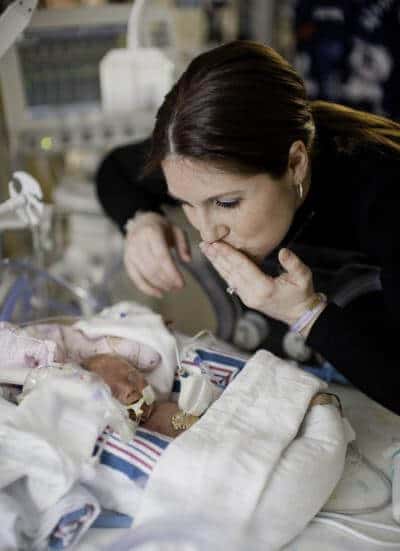Six states – Alaska, California, Maine, New Hampshire, Oregon and Vermont – earned an “A” on the March of Dimes 2013 Premature Birth Report Card as their preterm birth rates met the March of Dimes 9.6 percent goal. The US preterm birth rate improved to the lowest rate in 15 years, but the change wasn’t enough to earn it a better grade. The nation again earned a “C” on the Report Card.
The March of Dimes estimated that, since 2006, about 176,000 fewer babies have been born too soon because of improvement in the preterm birth rate, potentially saving about $9 billion in health and societal costs.
“Although we have made great progress in reducing our nation’s preterm birth rate from historic highs, the US still has the highest rate of preterm birth of any industrialized country. We must continue to invest in preterm birth prevention because every baby deserves a healthy start in life,” said March of Dimes President Dr. Jennifer L. Howse. “A premature birth costs businesses about 12 times as much as uncomplicated healthy birth. As a result, premature birth is a major driver of health insurance costs not only for employers.
The national preterm birth rate peaked in 2006 at 12.8 percent after rising steadily for more than two decades, according to the National Center for Health Statistics. The 2012 rate is a 10 percent improvement since the 2006 peak and the best rate since 1998. When compared to 2006, almost all states had lower preterm birth rates in 2012.
Disparities Gap Slowly Narrowing
The 2012 preterm birth rate among non-Hispanic black infants remains the highest of all the racial groups at 16.5 percent, down from 18.5 percent in 2006 and the lowest in more than 20 years. The gap between blacks and whites has been slowly narrowing, but the preterm birth rate among non-Hispanic blacks is still more than 1.5 times the rate of non-Hispanic whites.
Preterm birth (before 37 weeks of pregnancy,) is a serious health crisis that costs the US more than $26 billion annually, according to the Institute of Medicine. It is the leading cause of newborn death, and babies who survive an early birth often face the risk of serious and sometimes lifelong health problems, such as breathing problems, jaundice, developmental delays, vision loss and cerebral palsy. Babies born just a few weeks too soon have higher rates of death and disability than full-term babies. Even infants born at 37-38 weeks of pregnancy have an increased risk for health problems compared to infants born at 39 weeks.
On the 2013 Report Card, 31 states, the District of Columbia, and Puerto Rico saw improvement in their preterm birth rates between 2011 and 2012, earning seven – Alaska, California, District of Columbia, Georgia, Indiana, Kentucky and New Jersey – better grades. Nineteen states earned a “B,” 17 states and the District of Columbia received a “C,” five states got a “D,” and only three states and Puerto Rico received an “F” on the report card.
California’s success in achieving the March of Dimes goal is noteworthy. Not only is California home to half a million births each year, the most of any state, it also has a racially diverse population in a mix of urban, suburban and rural communities that have a variety of healthcare and economic needs.
The March of Dimes Report Card compares each state’s preterm birth rate to the March of Dimes goal of 9.6 percent of all live births by 2020. The Report Card information for the U.S. and states are available online at: marchofdimes.com/reportcard.
The Report Card also gauges states’ progress toward lowering their preterm birth rates by tracking contributing factors.
- 37 states, the District of Columbia and Puerto Rico reduced the percentage of uninsured women of childbearing age;
- 35 states and the District of Columbia reduced the percentage of women of childbearing age who smoke;
- 28 states the District of Columbia and Puerto Rico lowered the late preterm birth rate, infants born between 34 and 36 weeks gestation.


This is good news but we can and should do better as the United States! My daughter Joy was born in NY
at 23 weeks last year. Due to modern medicine and prayers she is doing
great today. I hemorrhaged at 17 weeks for the first of 4 times because of
100% placenta previa, which turned into placenta accreta (which I believe
was caused by 3 prior c-sections). After she came home from 121 days in
the NICU, I wrote a memoir called “From Hope To Joy” about my
life-threatening pregnancy and my daughter’s 4 months in the NICU (with my 3
young sons at home), which is now available on both the Amazon and
Barns&Noble websites. It was quite a roller coaster that I am certain some
of you have been on or are currently riding on. My mission is to provide hope
to women struggling with high-risk pregnancies, encourage expectant mothers to
educate themselves before electing cesarean deliveries, provide families of
premature babies a realistic look at what lies ahead in their NICU journey,
and show that miracles can happen, and hope can turn into joy. Please see my
website http://www.micropreemie.net and http://www.facebook.com/jenniferdegl